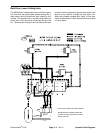
General Information
Hydraulic Hoses
Hydraulic hoses are subject to extreme conditions such
as, pressure differentials during operation and exposure
to weather, sun, chemicals, very warm storage condi-
tions or mishandling during operation or maintenance.
These conditions can cause damage or premature de-
terioration. Some hoses, such as reel motor hoses, are
more susceptible to these conditions than others. In-
spect the hoses frequently for signs of deterioration or
damage. To prevent possible problems it is recom-
mended that hoses are replaced periodically, regardless
of condition.
When replacing a hydraulic hose, be sure that the hose
is straight (not twisted) before tightening the fittings. This
can be done by observing the imprint on the hose. Use
two wrenches; one to hold the hose straight and one to
tighten the hose swivel nut onto the fitting.
Before disconnecting or performing any work
on the hydraulic system, all pressure in the
system must be relieved by stopping the en-
gine and lowering the cutting units to the
ground.
Keep body and hands away from pin hole
leaks or nozzles that eject hydraulic fluid un-
der high pressure. Use paper or cardboard,
not hands, to search for leaks. Hydraulic fluid
escaping under pressure can have sufficient
force to penetrate the skin and do serious
damage. If fluid is injected into the skin, it
must be surgically removed within a few
hours by a doctor familiar with this type of
injury or gangrene may result.
Hydraulic Fitting Installation
O-Ring Face Seal (Fig. 1, 2)
1. Make sure both threads and sealing surfaces are free
of burrs, nicks, scratches, or any foreign material.
2. Make sure the O-ring is installed and properly seated
in the groove. It is recommended that the O-ring be
replaced any time the connection is opened.
3. Lubricate the O-ring with a light coating of oil.
4. Put the tube and nut squarely into position on the face
seal end of the fitting and tighten the nut until finger tight.
5. Mark the nut and fitting body. Hold the body with a
wrench. Use another wrench to tighten the nut to the
correct flats from finger tight (F.F.F.T.). The markings on
the nut and fitting body will verify that the connection has
been tightened.
Size F.F.F.T.
4 (1/4 in. nominal hose or tubing) .75 ± .25
6 (3/8 in.) .75 ± .25
8 (1/2 in.) .75 ± .25
10 (5/8 in.) 1.00 ± .25
12 (3/4 in.) .75 ± .25
16 (1 in.) .75 ± .25
Figure 1
Figure 2
WARNING
Nut
Body
Sleeve
Seal
Mark Nut
and Body
Final
Position
Extend Line
Initial
Position
Finger Tight After Proper Tightening
Greensmaster
®
3100 Page 4 - 3 General Information


















